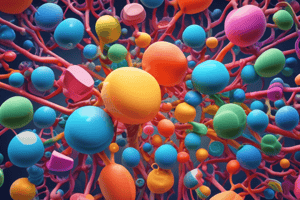Podcast
Questions and Answers
What are the building blocks of proteins?
What are the building blocks of proteins?
- Glycerol + Fatty acids
- Monosaccharides
- Nucleotides
- Amino acids (correct)
Which type of energy is associated with objects in motion?
Which type of energy is associated with objects in motion?
- Potential energy
- Kinetic energy (correct)
- Chemical energy
- Mechanical energy
According to the First Law of Thermodynamics, which of the following statements is true?
According to the First Law of Thermodynamics, which of the following statements is true?
- Energy cannot be transferred to new forms.
- Energy increases in an isolated system.
- Energy can be created but not destroyed.
- Energy can only be transformed and transferred. (correct)
Which type of work is involved in muscle contraction?
Which type of work is involved in muscle contraction?
What happens to energy during every transfer according to the Second Law of Thermodynamics?
What happens to energy during every transfer according to the Second Law of Thermodynamics?
Which of the following best defines potential energy?
Which of the following best defines potential energy?
What is the primary function of chemical energy in cells?
What is the primary function of chemical energy in cells?
What role do carbohydrates play in energy metabolism?
What role do carbohydrates play in energy metabolism?
What occurs during an exergonic reaction?
What occurs during an exergonic reaction?
Which type of reaction requires energy input to synthesize large organic molecules?
Which type of reaction requires energy input to synthesize large organic molecules?
What best describes catabolism?
What best describes catabolism?
During oxidation, what happens to an atom or molecule?
During oxidation, what happens to an atom or molecule?
What is the primary function of redox reactions in cells?
What is the primary function of redox reactions in cells?
Which statement is true regarding endergonic reactions?
Which statement is true regarding endergonic reactions?
Which of the following molecules is a product of catabolic reactions?
Which of the following molecules is a product of catabolic reactions?
What does a negative free energy change (ΔG < 0) indicate about a chemical reaction?
What does a negative free energy change (ΔG < 0) indicate about a chemical reaction?
Study Notes
Food/Nutrients and Building Blocks
- Macromolecules provide the building blocks for cells.
- Food provides the energy needed for cellular processes.
- Examples of food and their corresponding macromolecules:
- Bun: Carbohydrates
- Cheese: Protein and fats
- Patty: Protein and fats
- Tomatoes: DNA and RNA
Energy Flow
- First Law of Thermodynamics: Energy is conserved, it can be transferred but not created or destroyed.
- Second Law of Thermodynamics: Entropy (disorder) increases in an isolated system. Energy transfer leads to some energy loss as heat, resulting in increased entropy.
Why Do We Need Energy?
- Chemical work: Combining molecules (e.g., glucose forming polysaccharides).
- Transport work: Moving molecules across cell membranes (e.g., active transport).
- Mechanical work: Cellular movements like muscle contraction and flagella rotation.
Types of Energy
- Kinetic energy: Energy of motion (e.g., heat, light, walking).
- Potential energy: Stored energy (e.g., a monkey on a tree, ions on one side of a membrane).
- Chemical energy: Potential energy stored in chemical bonds. Released when bonds break.
Chemical Reactions and Energy
- Molecules have potential energy stored in their chemical bonds.
- Breaking bonds releases energy (exergonic reaction) with a negative free energy change (ΔG).
- Forming bonds requires energy (endergonic reaction) with a positive free energy change (ΔG).
Metabolism
- The sum of all chemical reactions in a cell.
- Catabolism: Breaking down large molecules into smaller ones, releases energy (ΔG < 0).
- Anabolism: Building up complex molecules from smaller ones, requires energy (ΔG > 0).
Oxidation-Reduction Reactions (Redox Reactions)
- Oxidation: Removing electrons from a molecule, often releases energy.
- Reduction: Gaining electrons, often requires energy.
- Redox reactions transfer energy between molecules by the flow of electrons. Cells use redox reactions to transfer energy.
Studying That Suits You
Use AI to generate personalized quizzes and flashcards to suit your learning preferences.
Related Documents
Description
This quiz covers the essential concepts of macromolecules as building blocks of cells, energy flow according to the laws of thermodynamics, and the different types of energy relevant to biological systems. Understand how food provides energy and how various forms of work are performed at the cellular level.




